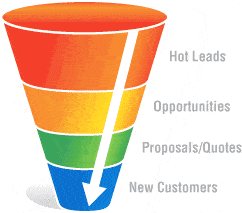Marketing Analytics: Turning Your Sales Funnels Into Data
 Regardless of the size of your business, you probably have an idea of what your sales funnel looks like. Just in case you’re green on all this, your sales funnel refers to the process a customer goes through before buying from you. This process spans the time at which they become a lead through their (sometimes long) decision-making process, right up until the moment the sale happens. In most cases, a sale doesn’t mean the buyer is out of your funnel. Once customers buy there’s always the chance they can become repeat customers – thus, once in your funnel, customers are almost always in there. Sound marketing analytics can give you some idea of what stages of your funnel a typical customer is in and for how long.
Regardless of the size of your business, you probably have an idea of what your sales funnel looks like. Just in case you’re green on all this, your sales funnel refers to the process a customer goes through before buying from you. This process spans the time at which they become a lead through their (sometimes long) decision-making process, right up until the moment the sale happens. In most cases, a sale doesn’t mean the buyer is out of your funnel. Once customers buy there’s always the chance they can become repeat customers – thus, once in your funnel, customers are almost always in there. Sound marketing analytics can give you some idea of what stages of your funnel a typical customer is in and for how long.
Many business owners give the side-eye to the thought of truly sitting down to look at their marketing analytics. There are a variety of reasons for this – one could be lack of ability to interpret the data. Another could be the lack of easy tools one can use to track and interpret the data, as well as integrate it into the rest of your marketing plan.
Marketing Analytics Help You Make Decisions
The truth is, if you’re not digging into your marketing analytics to help you inform future directions for your business, you’re missing a hotbed of potential for new decisions and creativity in your business. Here are some examples:
Setting up Goals: Google Analytics allows you to set up Goals in your Analytics install. Goals can be used to track the actions users take on your site. For instance, if you want to see how often users who come to a certain page will click through a sequence of pages before filling out a form, Goals can track that. If you’d like to see how many users from Facebook are taking a certain action on your site, Goals can help you. Goals are a great way to set up and take full advantage of marketing analytics based on your funnel.
- You can learn more about setting up Goals at: http://support.google.com/analytics/bin/answer.py?hl=en-GB&answer=1032415 or watching some helpful videos such as
- Melinda Samson’s Setting Up and Using Analytics Goals: https://www.youtube.com/watch?v=ZDNkXdOuhBc
- John Duffy’s Advanced Use of Analytics: https://www.youtube.com/watch?v=ijniFqC3PaM
Refining Your Funnel: Your sales data might actually show you that your funnel needs work. Are you overestimating the amount of time it takes for a client to decide they should use your services? Data will corroborate these kinds of hunches.
Marketing Analytics: Putting it all in the Cloud
Every organization should be watching to see how Marketing Analytics shows customers behaving on and using their site. You should be including data from your Marketing Analytics tools in your lead management system to give you detailed info about your leads. What is your typical lead conversion time? Where do the most highly converted leads come from? Are you truly getting the best ROI out of your marketing?
Lead Liaison is a system that can integrate marketing analytics and lead data to show you if your marketing decisions are helping you make the most out of your leads. It’s time to take a tour and ensure marketing analytics informs your business decisions today.











